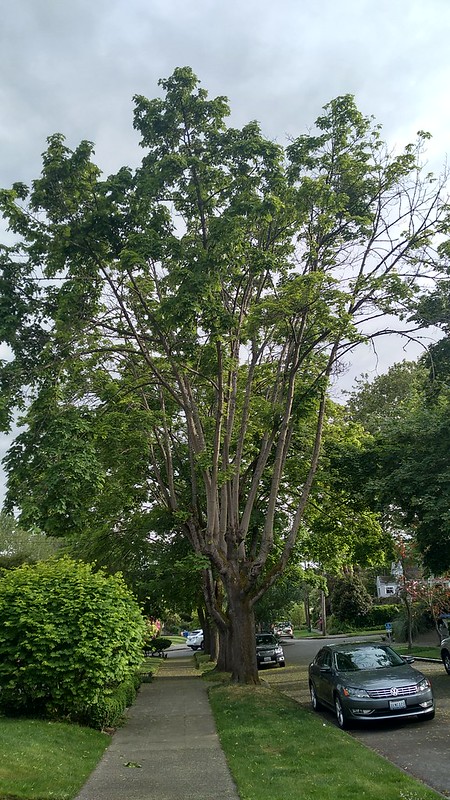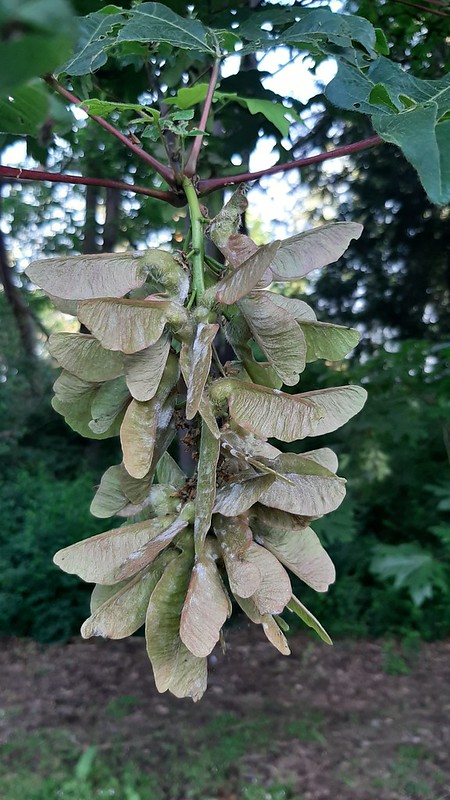Bigleaf Maple Dieback
Introduction
Dieback of bigleaf maple has been observed throughout the region during the past decade. A recent study out of University of Washington indicated that 22% of the maples sampled from 59 randomly selected sites in western Washington had symptoms of dieback. This finding is of enormous concern given the importance of this species economically, ecologically and culturally.
Unfortunately, a definitive cause has not been identified, although pests and pathogens have been widely considered (see PNW Handbook webpage). However, the dieback is known to be associated with several environmental variables such as vapor pressure deficits and higher temperatures, which is expected for most tree species. Still, more research is needed to confirm whether recent changes in these variables are the primary drivers of the dieback.
More information about the importance of bigleaf maple, the symptoms of dieback and the available resources for understanding the trends are listed below.
Bigleaf Maple
The Northwest Maple
Bigleaf maple is another iconic species of the Pacific Northwest. Where many maple species occur in other regions of the US, Bigleaf maple is the only native maple to the Northwest’s coastal regions.
The distribution of bigleaf maple generally reflects its adaptation to mild climates and sensitivity to cold temperatures. It grows abundantly on the west side of the cascades between sea level and about 1500ft, sometimes reaching as high as 4000 feet in California and Oregon.
As the name suggests, bigleaf maple is easily distinguished from other maples because of its large leaves. Look for the large hand shaped leaves with deeply cut lobes reaching up to a foot long.
Links to More Information
Identification
- PNW Plants, WSU Clark County Extension
- USDA Plant Profile
- The Jepson Herbarium
- E-Flora BC: Electronic atlas of the flora of British Columbia
- Native Plants PNW
- Natural Resources Canada
- Landscape Plants, Oregon State University Department of Horticulture
Biology and Ecology
- Index of Species Information, Fire Effects Information System, USDA Forest Service
- Bigleaf Maple, Oregon Wood Innovation Center
Ethnobotany
- Native American Ethnobotany Data Base, University of Michigan
Distribution
Pests and Disease
- Leaf Spots, Pacific Northwest Pest Management Handbooks, Oregon State University
- Powdery Mildew, Pacific Northwest Pest Management Handbooks, Oregon State University
- Wood Decay, Pacific Northwest Pest Management Handbooks, Oregon State University
- Verticillium wilt, Washington Department of Natural Resources
Importance
Bigleaf maple is an important species to the Pacific Northwest because of its commercial, ecological, cultural value.
Commercially, bigleaf maple is coveted by craftsman and woodworkers for fine furniture and custom products such as guitars and pianos. As the largest growing hardwood species in the region, slabs of bigleaf maple are highly prized because of its size, immaculate grain patterns, and common fungal compartmentalization and discoloration known as spalting.
Ecologically, the abundant leaf litter dropped from bigleaf maples each fall enriches the soil and the trees provide substrates for substantial growth of mosses, lichens, and even ferns. The characteristic helicopter seeds also provide valuable nourishment for many invertebrates living in our forests. In urban environments, it is an valuable source of shade, sometimes growing as wide as it is tall in open areas such as parks.
Cultural Heritage
Bigleaf maple is known as the ‘paddle tree’ in many First Nation languages because of its superior quality as a strong and light wood for paddles and spindle whorls (Pojar and MacKinnon 1994). The wood is also important for crafting utensils and the inner bark was woven into baskets (Moerman 1998).
Seeds and sprouts are also edible and comparable to alfalfa sprouts (Arno & Hammerly 2007).
The enormous leaves have also been used as temporary containers and to cover food in cooking pits.
- Arno SF, Hammerly RP. Northwest trees. Mountaineers; 2007.
- Moerman DE. Native American ethnobotany. Timber press; 1998.
- Pojar J, MacKinnon A. Plants of coastal British Columbia. Lone Pine Publishing; 1994.
Please contact us if you have any suggestions/corrections for this webpage.
Concern
Summary
Unfortunately, many reports of dieback have been noted during the past decade (see below). Observations of declining maples have been made throughout western Washington and Oregon since 2010.
Symptoms
Symptoms of dieback include thinning and entire crown dieback. Branches sometimes have clumps of unnaturally small leaves and heavy seed crops. Leaves may appear chlorotic (yellow-ish) and with tips and edges that resemble leaf scorch.
The Cause
The precise cause of the dieback remains unknown. However, research has revealed an association between dieback and environmental variables such as temperature and the proximity to urban interface.
Share your observations!
How to Contribute
You can share your observations of healthy and unhealthy bigleaf maple trees on iNaturalist.
Steps to contribute include:
- Create a login at iNaturalist.org
- (optional) Download the iNaturalist Mobile App
- Join the Bigleaf Maple Health Watch project.
- Add an observation on your mobile device or iNaturalist.org
- Tag the Bigleaf Maple Health Watch project in the observation
- Answer the project questions
- Share the observation!
Reports of Dieback Concerns
Theses
- Betzen J. 2019. Bigleaf maple decline in western Washington, University of Washington, February 22, 2019.
Posters
- Omdal D. and Ramsey-Kroll A. 2012. Assessing the role of Verticillium wilt in Bigleaf Maple (Acer macrophyllum) dieback in Western Washington, Washington Department of Natural Resources.
Book Sections
- Maple (Acer spp.)—Bigleaf maple (Bigleaf maple dieback), PNW Pest Management Handbook, OSU, WSU and UI Extension 2015.
News Articles
- DNR, 2019. Why is my tree dying? How drier summers affect native trees. Ear to the Ground, Department of Natural Resources.
- Clancy A. 2018. Big-leaf maples are dying—and the cause is a mystery, KIRO, September 13, 2018.
- Sailor C. 2018. Some of Washington’s biggest trees are dying and scientists don’t know why, The (Tacoma) News Tribune, September 9, 2018.
Blog Posts
- WADNR. 2019. Bigleaf maple decline, results of UW study, Washington Department of Natural Resources, Tree Link News, February 4, 2019.
- WADNR. 2016. Bigleaf maple decline, update and next steps, Washington Department of Natural Resources, Tree Link News, August 10, 2016.
- WADNR. 2015. What’s going on with Bigleaf maple? Washington Department of Natural Resources, Tree Link News, September 10, 2015.
- WADNR. 2014. Bigleaf maple dieback in western Washington? Washington Department of Natural Resources, Tree Link News, October 16, 2014.
WSU Puyallup Research & Extension Center, 2606 West Pioneer, Puyallup, WA, 98371-4998 USA
Home | Contact Us | Jobs | Citizen Science | Our Community | Support Our Program











